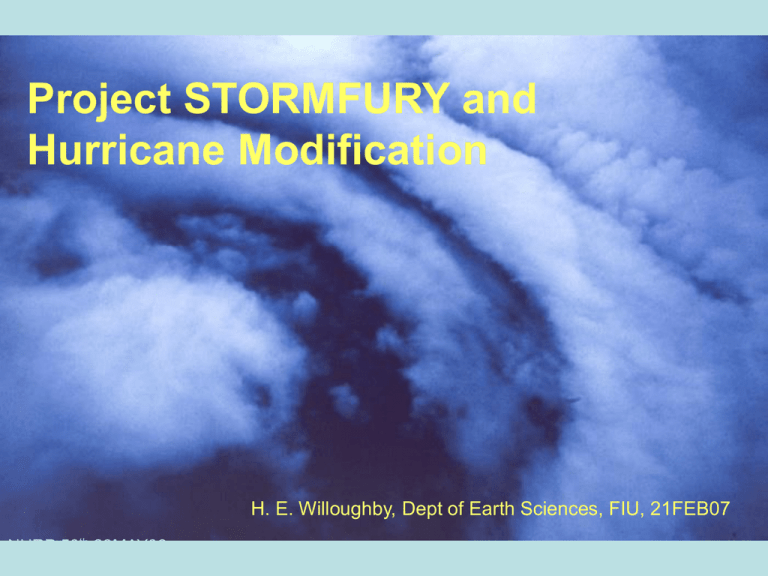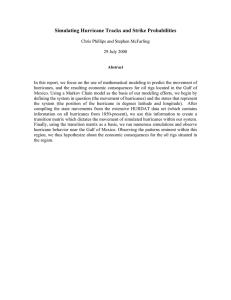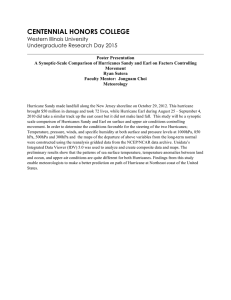Feb. 22, Hugh Willoughby, STORMFURY
advertisement

Project STORMFURY and Hurricane Modification H. E. Willoughby, Dept of Earth Sciences, FIU, 21FEB07 NHRP 50th 23MAY06 Vapor pressure over ice is lower than that over water at the same temperature Supercooled Water • Both freezing and condensation generally require nuclei to start the process • Natural clouds have plenty of condensation nuclei (100,000/liter) but few freezing nuclei (10-100/liter) • Consequently clouds colder than 0oC often contain liquid H20 that has not yet frozen. • May be as cold as -20oC • When some ice does form, – the ice crystals grow – at the expense of supercooled water droplets – Bergeron-Findeisen process • Artificial freezing nuclei can promote growth of snow that melts to form rain Cloud Seeding • Vincent Shaefer discovered that CO2 crystals can start clouds freezing, 1946 • Bernard Vonnegut discovered that Silver Iodide works, too • Kurt Vonnegut and Ice-9 • Irving Langmuir goes nuts PROJECT CIRRUS • • • • • Army, Navy, General Electric Co. GE quits because of legal worries Extensive seeding with AgI smokes to increase rainfall Exaggerated claims of success Seeded a hurricane off Georgia/Florida coast – 13 October 1947 – 80 kg of solid CO2 – Some change in clouds on radar but no other documented changes – Reversed track to landfall in Georgia and South Carolina • But Robert Simpson worked to start a National Hurricane Research Project, modeled on the Thunderstorm Project Memorable Hurricanes of 1954 & 1955 Navy P2-V Lost in Hurricane Janet Results of the 1954 & 1955 Seasons • Hurricanes Carol, Edna, Hazel, Connie, Diane & Ione – 400 dead – $2B damage (adjusted to 2005) • Congress starts National Hurricane Research Project National Hurricane Research Project • Study hurricane formation • Study hurricane structure and dynamics • Seek means for hurricane modification • Seek means for improvement of forecasts NHRP, 1959 Started in West Palm Beach Using Military Aircraft Soon Had Its Own Airplanes and Crews WB-57 2 DC-6s WC-130B Modification Strategy • Well thought-out, mainstream science • Trigger symmetric instability, or • Construct an outer eyewall, through cloud seeding with AgI • Required abundant supercooled water • Expanded eye should have weaker winds through partial conservation of angular momentum Bob and Joanne Simpson Initial STORMFURY Hypothesis Inertial instability: Wind decreases faster than 1/r Latent Heats of Condensation, Freezing and Deposition • Condensation Lc/cp = 2.5 oC per gm/kg • Freezing Lf/cp = 0.334 oC per gm/kg • Deposition Ld/cp = 2.834 oC per gm/kg • Condensate loading: It takes 3 gm/kg of liquid or ice to offset the buoyancy of 1oC temperature excess. • That 1oC of temperature excess can generate a >20 m/s updraft that reaches the tropopause. Entraining Bubble Models • Cloud composed of discrete bubbles • Entrainment balances detrainment so mass stays constant • Entrainment dilutes – Buoyancy – Moisture – Upward momentum • Large bubbles entrain less per unit volume: Hot Towers • Detrained water moistens environment for next bubble • Hydrometeors fall out of the bottom of each bubble • Models based on these physics used to assess seeding efficacy Dynamic Seeding Extra buoyancy by freezing supercooled water Revised STORMFURY Hypothesis • Targeted intense hurricanes with small eyes • Seed the first rainband outside the eye • Build a new eyewall around the old • New eyewall strangles the old STORMFURY Hurricanes Apparent Successes Beulah, 1963 Esther, 1961 Summary of STORMFURY Experiments Year 1961 Hurricane Esther Result 1963 Beulah 2 Attempts: I, Apparently missed. Did not fit experimental design. II; Eye reformed, winds weaker by 20% 1969 Debbie 2 Attempts, both apparently successful. Winds apparently by weakened by 31% and 15% 1971 Ginger 2 Attempts, did not fit experimental design, no effect 2 Attempts: I, Apparently slowed intensification; II, Missed eyewall (Hypothesis I) Feasibility Criteria • Political: Willingness to spend money and accept risks • Operational: Aircraft, intruments, scientists and aircrew available • Microphysical: Clouds with supercooled water • Dynamic: Hurricanes vulnerable to modification strategy • Statistical: Had to be able to distinguish the results of seeding from natural behavior NOAA WP-3Ds Procured to replicate Debby experiments Lack of hurricanes in the target area led to extensive observations of unmodified hurricanes Concentric Eyewalls in Unmodified Hurricanes Hurricane Allen New Understanding of Structure & Dynamics • Most updrafts weaker than previously thought • Inclined updrafts unloaded condensate • Liquid water contents lower • Observations of widespread radar brightband • Widespread stratiform rain and mesoscale up- & downdrafts Jorgensen 1984b Spaceborne Remote Sensing Revealed Many Concentric Eyewalls Particle Measurement Systems Probes Little supercooled water at temperatures < -10oC found ICE WATER Ice Multiplication • Radar and Knollenberg probes showed little ice • Hallett-Mossop Process – Graupel undergoing wet accretion of supercooled clouds droplets grow whiskers-like ice crystals – -8 < T < -3oC, – Droplet diameter > 23 μm – Break off – Natural cloud seeding • Happens in maritime clouds only • Explains lack of supercooled water • Doesn’t look good for cloud seeding in the tropics Hallett & Mossop, 1974, Science STORMFURY Abandoned Because • Limited supercooled water • Eye expansion happens in unmodified hurricanes • Political difficulty with finding experimental subjects Other Strategies • Slicks to retard heat surface heat transfer • Artificial ocean cooling • Nuke-em • Fans to blow hurricanes away from shore • Exploit sensitivity to initial conditions • Get them while they are little • Most proposals underestimate the scale of the undertaking Protocol for Future Hurricane Modification Strategies • Laboratory or small-scale field trial • Numerical simulation • Quantitative plan for logistics and operations • Assessment of benefits in relation to costs DC6 Crew Summary • • • • • NHRP grew from hurricane disasters of 1954 & 1955 Bob & Joanne Simpson “Amelioration” was part of the original mission Dynamic seeding to increase cumulus buoyancy Two hypotheses – Trigger inertial (or symmetric) instability – Construct outer eyewall – Weakening through eye expansion under partial conservation of angular momentum • Tried 8 times in 4 hurricanes with apparent 50% success. • Abandoned because: – Not enough supercooled water (Hallett Mossop) – Natural eyewall replacements mimic expected experimental results – Political problems with finding subjects and resources





